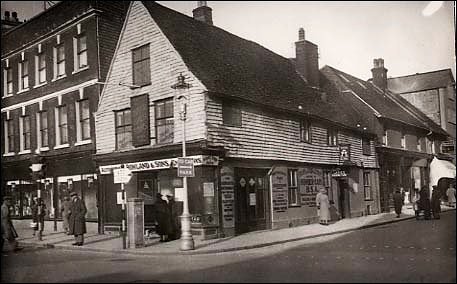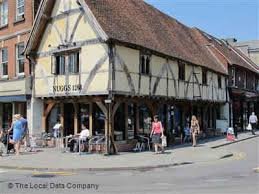
hiStory
Innovating for a global palate since 1950.
Welcome to the Pickled Frog
We took over this fantastic building in January 2022 – little knowing quite what trials and tribulations it would bring with it!
Between us, we’ve got years of experience in the hospitality trade and were excited to start this new venture. It hasn’t always been easy – running a café-bar in a medieval listed building is as rewarding as it is challenging.
The restrictions on what you can and can’t do to a listed property are legendary – but somehow, you're still expected to survive and thrive! With no central heating or air conditioning, it’s cold in the winter, hot in the summer, and yes – in the warmer months, you really can see daylight between the beams and the plaster. But we love it. And we hope you will too.
A Building Steeped in History
51 Blue Boar Row dates back to around 1420 and is a classic Market Square corner tenement – one of Salisbury’s oldest. It’s timber-framed, and the jettied joists and bressummer beams you see today were only fully revealed during recent renovations.
The original frame was made up of four bays, supported by five oak trusses – collared tie-beams with elegant curved braces on the ground floor. During restoration, rafters were found to be smoke-blackened – a clue that open braziers once heated the space below, with smoke escaping through loosely tiled roofing. Amazingly, some of the original wattle and daub also survives.
Reinvention Through the Centuries
Over the centuries, the building has been altered many times. In the late 1700s and early 1800s, the ground floor timber framing was removed to make way for shop windows. A new attic floor was added in the 19th century – accessed by a steep, ladder-style staircase – and by the mid-20th century, large sections of the shop front were replaced with modern designs and boarding, concealing much of the original jetty.
Between 2005 and 2006, the building underwent a major restoration using English oak from the New Forest. As much of the original fabric as possible was retained – today, around 95% of the roof remains original, along with 60% of the first floor and (sadly) only 10% of the ground floor. Over 60 tonnes of rubbish were removed before work even began. In November 2006, the building was officially reopened and received the prestigious Lady Radnor Award for Conservation.
Nuggs Corner – A Salisbury Landmark
This site has been occupied for centuries. When Salisbury’s chequer layout was first planned, a large square was left for the market – and records from 1268 show a house already stood here, owned by a man named Hugh Nugg. The property stayed in the Nugg family for over 200 years and became known as Nuggs Corner.
Since then, many Salisbury citizens have lived and worked here. In the early 20th century, the building was home to a ladies’ outfitter, Rowland & Sons coach booking office, and Dobell & Shearman’s typewriter shop. After WWII, it became Stoners Café, then Mr T’s in the 1970s – later gaining an internet café on the upper floor. After renovation, it was briefly named Nuggs 1268, then The Blue Boar Bistro.
Today – The Pickled Frog
Today, we’re proud to continue the café tradition at The Pickled Frog – a family-run Café, Bar and Bistro serving freshly prepared food: tapas, light bites, sharing platters, main meals, and an excellent selection of wines, beers, spirits, and cocktails.
Come in, take a seat, and enjoy a menu full of flavour in a building full of history – crafted by the hands of medieval builders and modern-day restorers alike.
A Friendly Ghost?
Local legend says a young girl named Matilda still walks the upper floors. Said to have died of diphtheria many years ago, her spirit is sometimes felt in the quiet moments. We like to think she just enjoys the company.
LEAD STAFF
Amanda & Kevin Daley
Owners
Amanda Daley
Executive Chef
Robert Daley
Manager & Mixologist



